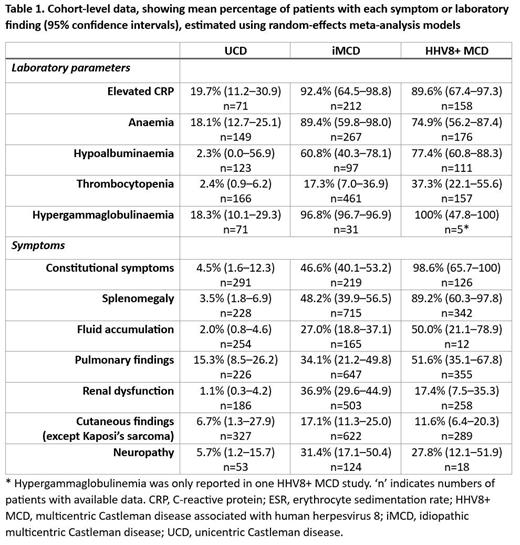Background: Castleman disease (CD) encompasses a spectrum of rare disorders with characteristic histopathological features, including unicentric (UCD), idiopathic multicentric (iMCD) and cases that are associated with the human herpesvirus 8 (HHV8+ MCD). As treatment options for each type of CD vary, it is important to be able to distinguish their clinical presentation from their subtypes and determine the correct diagnosis. To our knowledge, there are no major review articles summarising the clinical features of different CD subtypes. The aim of this study was to describe and compare the clinical presentation of different CD subtypes reported in the literature.
Methods: We performed a systematic review of publications reporting ≥5 cases of CD between 1995 and 2021, following the PRISMA guidelines. Publications were cross-checked by study location, data collection period and investigators to identify duplicated patients. Where a patient may have been included in >1 study, the publication with the fewest patients or least symptom data was excluded. For each subtype of CD within each study, we extracted data on demographics, clinical symptoms and laboratory parameters as stated in the international consensus diagnostic criteria for iMCD. We estimated the mean percentage of patients meeting each diagnostic criterion for each CD subtype using meta-analyses conducted with random-effects logistic regression models.
Results: We analysed 32 studies with 1998 patients from 16 countries, including 559 UCD, 1023 iMCD and 416 HHV8+ MCD cases. There was a predominance of males not only in HHV8+ MCD (88.5% males) but also in iMCD (59.1% males). Patients with UCD tended to be younger than patients with iMCD and HHV8+ MCD. Most patients with iMCD (91.8%) and UCD (84.7%) were of Asian ethnicity. Only 58 patients (6.4%) with iMCD were White. In contrast, almost all patients with HHV8+ MCD (93.7%) were White or Black/African American.
Many symptoms and laboratory abnormalities occurred at similar rates in patients with iMCD and HHV8+ MCD (Table 1). There were no significant differences in laboratory findings between patients with iMCD and HHV8+ MCD. However, compared with patients with HHV8+ MCD, patients with iMCD had significantly lower rates of constitutional symptoms (46.6% vs 98.6%, p=0.038) and splenomegaly (48.2% vs 89.2%, p=0.031). In contrast, renal dysfunction seemed to appear more commonly in iMCD (36.9% vs 17.4%, not statistically significant).
Patients with UCD had significantly lower rates of laboratory abnormalities vs those with iMCD and HHV8+ MCD (p<0.05 for all parameters listed in Table 1). Except for cutaneous findings, patients with UCD had significantly lower rates of symptoms than patients with either iMCD or HHV8+ MCD (p<0.05 for all non-cutaneous parameters in Table 1). However, elevated C-reactive protein (CRP), anaemia and hypergammaglobulinaemia occurred in almost 20% of patients with UCD and pulmonary findings were observed in 15.3% of cases.
We identified five additional publications including 88 paediatric patients with UCD. Paediatric patients with UCD had more signs of systemic inflammation than adult UCD patients. Elevated CRP was reported in 45.1% (95% CI 20.9-71.8, n=50) of paediatric UCD patients (vs 19.7% of adults [95% CI 11.2-30.9]). Constitutional symptoms were reported in 44.4% (95% CI 21.5-69.2, n=18) of patients - significantly higher than the rate reported in adult patients with UCD (4.5%, 95% CI 1.6-12.3; p=0.0005).
Conclusions: This systematic review complements the diagnosis and management guidelines for iMCD and UCD and provides a detailed description of the clinical presentation of HHV8+ MCD. We found several distinct differences between iMCD and HHV8+ MCD, probably reflecting the heterogeneity of the underlying pathomechanisms and/or different comorbidity burdens of these CD subtypes. We confirmed that systemic symptoms may be present in up to 20% of patients with UCD. Whether these cases represent a distinct entity and whether intermediate CD cases require systemic therapy beyond surgery remains to be elucidated.
Disclosures
Kanhai:Recordati Pharma Ltd: Current Employment. Littler:TVF Communications: Consultancy. McColl:TVF Communications: Consultancy. Grant:TVF Communications: Current Employment. Hoffmann:Janssen-Cilag: Honoraria, Research Funding, Speakers Bureau; Recordati: Honoraria, Research Funding, Speakers Bureau; Gilead Sciences: Honoraria, Research Funding, Speakers Bureau; MSD: Honoraria, Research Funding, Speakers Bureau; ViiV Healthcare: Honoraria, Research Funding, Speakers Bureau.


